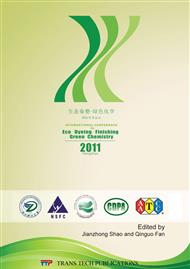p.116
p.122
p.127
p.132
p.138
p.145
p.150
p.155
p.160
Non-Aqueous Dyeing of Reactive Dyes in D5
Abstract:
C.I. Reactive Red 195 was used for non-aqueous dyeing in D5 (Decamethyl Cyclopentasiloxane) and appropriate surfactants were selected to ensure the dyes dispersed stably in D5 medium. The feasible method for reactive dyeing in dyes/D5 suspension system was established through repeated experiments. At the same time, taking the color depth (K/S value) as the evaluation index, the process factors in dyeing such as temperature, dyeing duration, pick-up ratio of alkali solution on fabric, as well as the alkali concentration were optimized for setting up dyeing conditions. The results showed that, the dye up-take could reach nearly 100% without any salt as accelerating agent. Since just a little water was used in the process, hydrolysis of reactive dyes was restrained, fixing rate was increased, and the apparent color depth of the dyed sample was much better than traditional water bath dyeing. The washing fastness and rubbing fastness of samples dyed in dyes/D5 system were satisfactory.
Info:
Periodical:
Pages:
138-144
Citation:
Online since:
January 2012
Authors:
Price:
Сopyright:
© 2012 Trans Tech Publications Ltd. All Rights Reserved
Share:
Citation:


